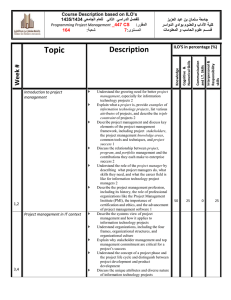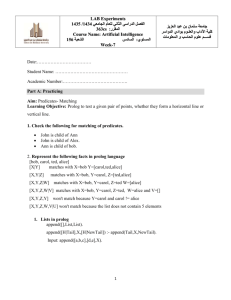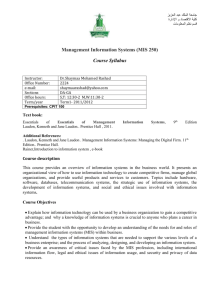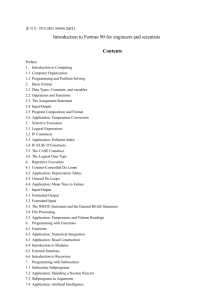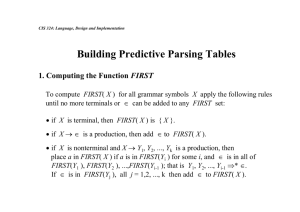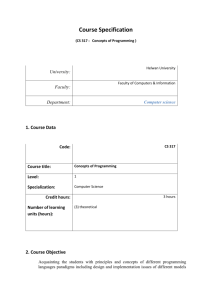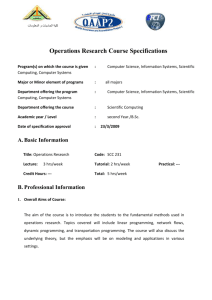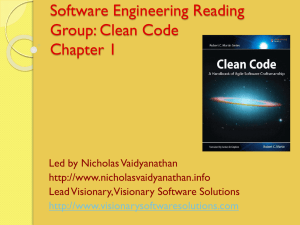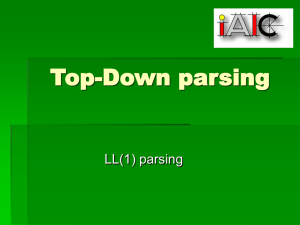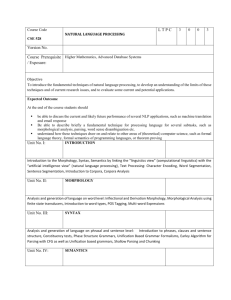File
advertisement
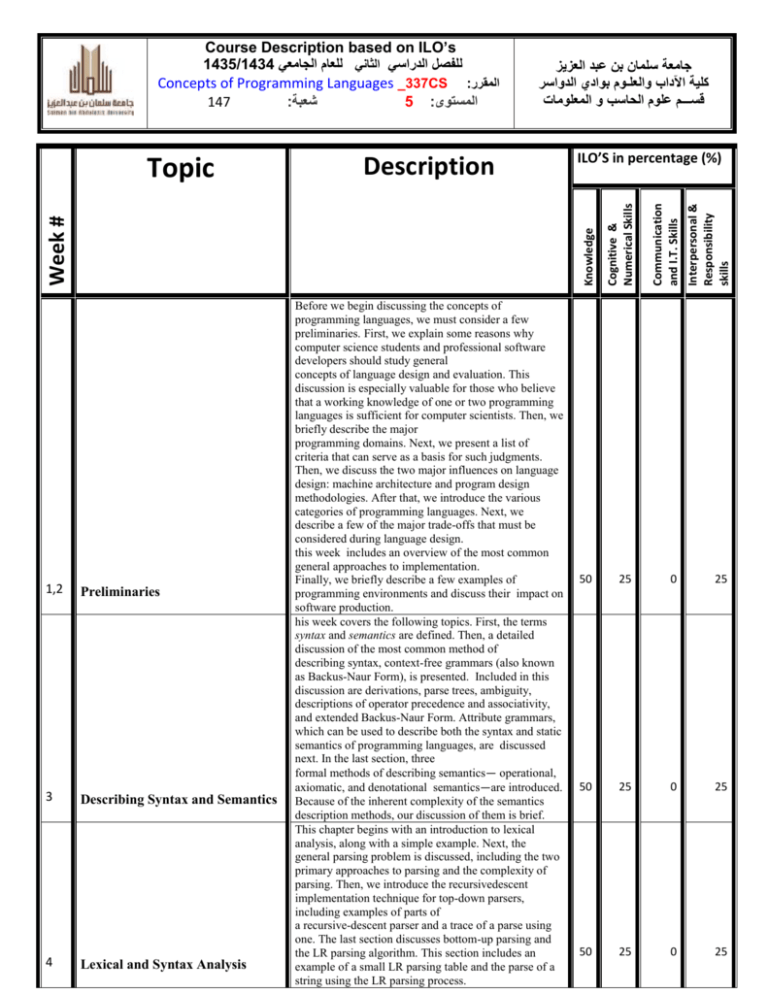
3 Describing Syntax and Semantics 4 Lexical and Syntax Analysis Interpersonal & Responsibility skills Preliminaries Communication and I.T. Skills 1,2 Before we begin discussing the concepts of programming languages, we must consider a few preliminaries. First, we explain some reasons why computer science students and professional software developers should study general concepts of language design and evaluation. This discussion is especially valuable for those who believe that a working knowledge of one or two programming languages is sufficient for computer scientists. Then, we briefly describe the major programming domains. Next, we present a list of criteria that can serve as a basis for such judgments. Then, we discuss the two major influences on language design: machine architecture and program design methodologies. After that, we introduce the various categories of programming languages. Next, we describe a few of the major trade-offs that must be considered during language design. this week includes an overview of the most common general approaches to implementation. Finally, we briefly describe a few examples of programming environments and discuss their impact on software production. his week covers the following topics. First, the terms syntax and semantics are defined. Then, a detailed discussion of the most common method of describing syntax, context-free grammars (also known as Backus-Naur Form), is presented. Included in this discussion are derivations, parse trees, ambiguity, descriptions of operator precedence and associativity, and extended Backus-Naur Form. Attribute grammars, which can be used to describe both the syntax and static semantics of programming languages, are discussed next. In the last section, three formal methods of describing semantics— operational, axiomatic, and denotational semantics—are introduced. Because of the inherent complexity of the semantics description methods, our discussion of them is brief. This chapter begins with an introduction to lexical analysis, along with a simple example. Next, the general parsing problem is discussed, including the two primary approaches to parsing and the complexity of parsing. Then, we introduce the recursivedescent implementation technique for top-down parsers, including examples of parts of a recursive-descent parser and a trace of a parse using one. The last section discusses bottom-up parsing and the LR parsing algorithm. This section includes an example of a small LR parsing table and the parse of a string using the LR parsing process. ILO’S in percentage (%) Cognitive & Numerical Skills Description Week # Topic جامعة سلمان بن عبد العزيز كلية اآلداب والعلـوم بوادي الدواسر قســـم علوم الحاسب و المعلومات Knowledge Course Description based on ILO’s 1435/1434 للفصل الدراسي الثاني للعام الجامعي Concepts of Programming Languages _337CS :المقرر 147 :شعبة 5 :المستوى 50 25 0 25 50 25 0 25 50 25 0 25 Course Description based on ILO’s 1435/1434 للفصل الدراسي الثاني للعام الجامعي Concepts of Programming Languages _337CS :المقرر 147 :شعبة 5 :المستوى جامعة سلمان بن عبد العزيز كلية اآلداب والعلـوم بوادي الدواسر قســـم علوم الحاسب و المعلومات This chapter introduces the fundamental semantic issues of variables. It begins by describing the nature of names and special words in rogramming languages. The attributes of variables, including type, address, and value, are then discussed, including the issue of aliases. The important concepts of binding and binding times are introduced next, including the different possible binding times for variable attributes and how they define four different categories of variables. Following that, two very different scoping rules for names, static and dynamic, are described, along with the concept of a referencing environment of a statement. Finally, named constants and variable 5 Names, Bindings, and Scopes initialization are discussed. 6 Data Types 7 Statement-Level Control Structures 8,9 Subprograms 10 Abstract Data Types and Encapsulation Constructs 11 Support for Object-Oriented Programming This chapter first introduces the concept of a data type and the characteristics of the common primitive data types. Then, the designs of enumeration and subrange types are discussed. Next, the details of structured data types specifically arrays, associative arrays, records, tuples, lists, and unions—are investigated.This section is followed by an in-depth look at pointers and references. For each of the various categories of data types, the design issues are statedand the design choices made by the designers of some common languages are described. These designs are then evaluated. The next three sections provide a thorough investigation of type checking, strong typing, and type equivalence rules. The last section of the chapter briefly introduces the basics of the theory of data types. The flow of control, or execution sequence, in a program can be examined at several levels. At the highest level is the flow of control among program units the important issue of the flow of control among statements, which is the subject of this chapter. Subprograms are the fundamental building blocks of programs and are therefore among the most important concepts in programming language design. We now explore the design of subprograms, including parameter-passing methods, local referencing environments, overloaded subprograms, generic subprograms, and the aliasing and problematic side effects that are associated with subprograms. We also include discussions of indirectly called 50 25 0 25 50 25 0 25 50 25 0 25 50 25 0 25 50 25 0 25 50 25 0 25 subprograms, closures, and coroutines. in this chapter, we explore programming language constructs that support data abstraction. Among the new ideas of the last 50 years in programming methodologies and programming language design, data abstraction is one of the most profound. This chapter begins with a brief introduction to objectoriented programming,followed by an extended discussion of the primary design issues for inheritance and dynamic binding. Next, the support for objectoriented programming in Smalltalk, C++, Objective-C, Course Description based on ILO’s 1435/1434 للفصل الدراسي الثاني للعام الجامعي Concepts of Programming Languages _337CS :المقرر 147 :شعبة 5 :المستوى 12 Exception Handling and Event Handling 14 Functional Programming Languages 15 Logic Programming Languages Course Instructor Dr. Abdalla Al-Ameen Signature…………………… جامعة سلمان بن عبد العزيز كلية اآلداب والعلـوم بوادي الدواسر قســـم علوم الحاسب و المعلومات Java, C#, Ada 95, and Ruby is discussed. The chapter concludes with a short overview of the implementation of dynamic bindings of method calls to methods in object-oriented languages. T his chapter discusses programming language support for two related parts of many contemporary programs: exception handling and event handling. Both exceptions and events can occur at times that cannot be predetermined, and both are best handled with special language constructs and processes. Some of these constructs and processes for example,propagation—are similar for exception handling and event handling. This chapter introduces functional programming and some of the programming languages that have been designed for this approach to software development. The objectives of this chapter are to introduce the concepts of logic programming and logic programming languages, including a brief description of a subset of Prolog. 50 25 0 25 50 25 0 25 50 25 0 25 The Supervisor of Department Dr. Saied M. Abd El-atty Signature………………
